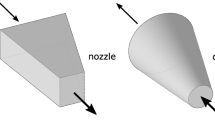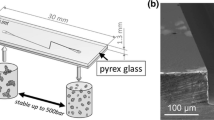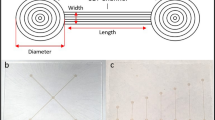Abstract
Plasma processing is used to create passive superhydrophobic on–off valves with tailored opening pressure inside microfluidic devices. First, anisotropic O2 plasma etching on polymeric microchannels is utilized to controllably roughen (nanotexture) the bottom of the microchannel. Second, the nanotextured surfaces are hydrophobized by means of a C4F8 plasma deposition step through a stencil mask creating superhydrophobic stripes or patches. The superhydrophobic patches play the role of on/off valves with predesigned opening pressure threshold (in the range 40–110 mbar), determined by the microchannel dimensions and the size of the nanotexture on the patch. These valves are integrated inside microchannel networks paving the way to autonomous microfluidic devices. To this aim, we present a novel preprogrammable flow switchboard that can split and control the liquid flow for multiple analysis purposes. The proposed valves present an example of how effectively plasma nanoscience and nanotechnology can be applied to microfluidics/nanofluidics and analytical chemistry.







Similar content being viewed by others
References
Accardo A, Gentile F, Mecarini F, De Angelis F, Burghammer M, Di Fabrizio E et al (2010) In situ X-ray scattering studies of protein solution droplets drying on micro- and nano-patterned superhydrophobic PMMA surfaces. Langmuir 26:15057–15064
Accardo A, Mecarini F, Leoncini M, Brandi F, Di Cola E, Burghammer M et al (2013) Fast, active droplet interaction: coalescence and reactive mixing controlled by electrowetting on a superhydrophobic surface. Lab Chip 13:332–335
Bazargan V, Stoeber B (2010) Flow control using a thermally actuated microfluidic relay valve. J Microelectromech Syst 19:1079–1087
Chung BG, Flanagan LA, Rhee SW, Schwartz PH, Lee AP, Monuki ES et al (2005) Human neural stem cell growth and differentiation in a gradient-generating microfluidic device. Lab Chip 5:401–406
Constantoudis V, Christoyianni H, Zakka E, Gogolides E (2009) Modeling of roughness evolution during the etching of inhomogeneous films: material-induced anomalous scaling. Phys Rev E Stat Nonlinear Soft Matter Phys 79:1604-1–1604-8
Di Mundo R, Palumbo F, d’Agostino R (2010) Influence of chemistry on wetting dynamics of nanotextured hydrophobic surfaces. Langmuir 26:5196–5201
Do J, Lee S, Han JY, Kai JH, Hong CC, Gao CA et al (2008) Development of functional lab-on-a-chip on polymer for point-of-care testing of metabolic parameters. Lab Chip 8:2113–2120
Gervais L, Delamarche E (2009) Toward one-step point-of-care immunodiagnostics using capillary-driven microfluidics and PDMS substrates. Lab Chip 9:3330
Gervais L, de Rooij N, Delamarche E (2011) Microfluidic chips for point-of-care immunodiagnostics. Adv Mater 23:H151–H176
Gleiche M, Chi LF, Fuchs H (2000) Nanoscopic channel lattices with controlled anisotropic wetting. Nature 403:173–175
Gnanappa AK, Papageorgiou DP, Gogolides E, Tserepi A, Papathanasiou AG, Boudouvis AG (2012) Hierarchical, plasma nanotextured, robust superamphiphobic polymeric surfaces structurally stabilized through a wetting–drying cycle. Plasma Process Polym 9:304–315
Goedecke N, McKenna B, El-Difrawy S, Carey L, Matsudaira P, Ehrlich D (2004) A high-performance multilane microdevice system designed for the DNA forensics laboratory. Electrophoresis 25:1678–1686
Gogolides E, Boukouras C, Kokkoris G, Brani O, Tserepi A, Constantoudis V (2004) Si etching in high-density SF6 plasmas for microfabrication: surface roughness formation. Microelectron Eng 73–74:312–318
Gogolides E, Constantoudis V, Kokkoris G, Kontziampasis D, Tsougeni K, Boulousis G et al (2011) Controlling roughness: from etching to nanotexturing and plasma-directed organization on organic and inorganic materials. J Phys D Appl Phys 44:174021
Handique K, Burke DT, Mastrangelo CH, Burns MA (2000) Nanoliter liquid metering in microchannels using hydrophobic patterns. Anal Chem 72:4100–4109
Kokkoris G, Constantoudis V, Angelikopoulos P, Boulousis G, Gogolides E (2007) Dual nanoscale roughness on plasma-etched Si surfaces: role of etch inhibitors. Phys Rev B Condens Matter Mater Phys 76:193405-1–193405-4
Laser DJ, Santiago JG (2004) A review of micropumps. J Micromech Microeng 14:R35–R64
Li PCH, Harrison DJ (1997) Transport, manipulation, and reaction of biological cells on-chip using electrokinetic effects. Anal Chem 69:1564–1568
Lu C, Xie Y, Yang Y, Cheng MMC, Koh C-G, Bai Y et al (2006) New valve and bonding designs for microfluidic biochips containing proteins. Anal Chem 79:994–1001
Man FP, Mastrangelo CH, Burns MA, Burke DT (1998) Microfabricated capillarity-driven stop valve and sample injector. In: IEEE Proceedings of the 1998 IEEE 11th Annual International Workshop on Micro Electro Mechanical Systems
Manz A, Graber N, Widmer HM (1990) Miniaturized total chemical-analysis systems—a novel concept for chemical sensing. Sens Actuators B Chem 1:244–248
Marquez-Velasco J, Vlachopoulou ME, Tserepi A, Gogolides E (2010) Stable superhydrophobic surfaces induced by dual-scale topography on SU-8. Microelectron Eng 87:782–785
Nguyen NT, Wu ZG (2005) Micromixers—a review. J Micromech Microeng 15:R1–R16
Papageorgiou DP, Tsougeni K, Tserepi A, Gogolides E (2012) Superhydrophobic, hierarchical, plasma-nanotextured polymeric microchannels sustaining high-pressure flows. Microfluid Nanofluidics 14:247–255
Suk JW, Cho JH (2007) Capillary flow control using hydrophobic patterns. J Micromech Microeng 17:N11–N15
Tserepi A, Gogolidis E, Misiakos K, Vlachopoulou M-E, Vourdas N (2006) Method for the fabrication of high surface area ratio and high aspect ratio surfaces on substrates. PCT/GR2006/000011
Tsougeni K, Vourdas N, Tserepi A, Gogolides E, Cardinaud C (2009) Mechanisms of oxygen plasma nanotexturing of organic polymer surfaces: from stable super hydrophilic to super hydrophobic surfaces. Langmuir 25:11748–11759
Tsougeni K, Papageorgiou D, Tserepi A, Gogolides E (2010a) “Smart” polymeric microfluidics fabricated by plasma processing: controlled wetting, capillary filling and hydrophobic valving. Lab Chip 10:462–469
Tsougeni K, Tserepi A, Constantoudis V, Gogolides E, Petrou PS, Kakabakos SE (2010b) Plasma nanotextured PMMA surfaces for protein arrays: increased protein binding and enhanced detection sensitivity. Langmuir 26:13883–13891
Tsougeni K, Koukouvinos G, Petrou PS, Tserepi A, Kakabakos SE, Gogolides E (2012a) High-capacity and high-intensity DNA microarray spots using oxygen-plasma nanotextured polystyrene slides. Anal Bioanal Chem 403:2757–2764
Tsougeni K, Petrou PS, Papageorgiou DP, Kakabakos SE, Tserepi A, Gogolides E (2012b) Controlled protein adsorption on microfluidic channels with engineered roughness and wettability. Sens Actuators B Chem 161:216–222
Vlachopoulou ME, Petrou PS, Kakabakos SE, Tserepi A, Beltsios K, Gogolides E (2009) Effect of surface nanostructuring of PDMS on wetting properties, hydrophobic recovery and protein adsorption. Microelectron Eng 86:1321–1324
Vourdas N, Tserepi A, Gogolides E (2007) Nanotextured super-hydrophobic transparent poly(methyl methacrylate) surfaces using high-density plasma processing. Nanotechnology 18:125304
Vourdas N, Tserepi A, Boudouvis AG, Gogolides E (2008) Plasma processing for polymeric microfluidics fabrication and surface modification: effect of super-hydrophobic walls on electroosmotic flow. Microelectron Eng 85:1124–1127
Vourdas N, Kontziampasis D, Kokkoris G, Constantoudis V, Goodyear A, Tserepi A et al (2010) Plasma directed assembly and organization: bottom-up nanopatterning using top-down technology. Nanotechnology 21:085302
Woias P (2005) Micropumps—past, progress and future prospects. Sens Actuators B Chem 105:28–38
Zakka E, Constantoudis V, Gogolides E (2007) Roughness formation during plasma etching of composite materials: a kinetic Monte Carlo approach. IEEE Trans Plasma Sci 35:1359–1369
Zimmermann M, Schmid H, Hunziker P, Delamarche E (2007) Capillary pumps for autonomous capillary systems. Lab Chip 7:119
Zimmermann M, Hunziker P, Delamarche E (2008) Valves for autonomous capillary systems. Microfluid Nanofluidics 5:395–402
Acknowledgments
Authors kindly acknowledge Associate Professor Grigoris Kaltsas from TEI of Athens, Department of Electronics, for his help in the pressure measurements by providing access to the setup shown in Fig. 1. This work was cofinanced by Hellenic Funds and by the European Regional Development Fund (ERDF) under the Hellenic National Strategic Reference Framework (NSRF) 2007–2013, of the Project “THALIS-DESIgn and fabrication of Robust supErhydrophobic/philic surfaces and their application in the realization of ‘smart’ microfluidic valves” (http://www.imel.demokritos.gr/projects/desiredrop/).
Author information
Authors and Affiliations
Corresponding author
Electronic supplementary material
Below is the link to the electronic supplementary material.
Supplementary material 3 (WMV 1224 kb)
Supplementary material 4 (WMV 2771 kb)
Rights and permissions
About this article
Cite this article
Ellinas, K., Tserepi, A. & Gogolides, E. Superhydrophobic, passive microvalves with controllable opening threshold: exploiting plasma nanotextured microfluidics for a programmable flow switchboard. Microfluid Nanofluid 17, 489–498 (2014). https://doi.org/10.1007/s10404-014-1335-9
Received:
Accepted:
Published:
Issue Date:
DOI: https://doi.org/10.1007/s10404-014-1335-9




